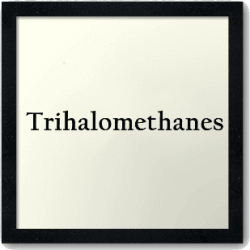Trihalomethanes
THMS as a Water Contaminant
The use of chlorine for disinfection can result in the formation of disinfection byproducts (DBPs). When chlorine is added to water with organic material, such as algae, river weeds, and decaying leaves, DBPs are formed. DBP formation is often more an issue in warm weather climates.
Of the identified DBPs the two classes of compounds of most concern are the trihalomethanes (THM), and haloacetic acids (HAA). They are typically tasteless and odorless, but suspected human carcinogens. The quantity of byproducts formed is determined by several factors, including the amount and type of organic material present in water, the composition and structure of the organic matter, temperature, pH, chlorine dosage, contact time available for chlorine, and bromide concentration in the water. Therefore, the optimal strategy to minimize DBP formation will likely require bench and pilot testing and some trial and error.
The range of DBPs that can be formed as a result of the interaction of chlorine and the organic matter in chlorine is not clearly understood. Therefore, a practice has developed in which the THM’s are used as indicator chemicals for all potentially harmful compounds formed by the addition of chlorine to the water.
Maximum Contaminant Level
The EPA’s Stage 2 Disinfectants/Disinfection Byproducts Rule sets the US maximum contaminant level for four THMS (chloroform, bromodichloromethane, dibromochloromethane and bromoform) and five HAAs (monochloro‐, monobromo‐, dichloro‐, dibromo‐, and trichloroacetic acids) at 80 μg/L and 60 μg/L, respectively, on the basis of a locational running annual average (as opposed to a system-wide average).
It is important to note that, given the residual chlorine in water, THM production can continue in the distribution system. Therefore, sampling sites in the distribution system are identified that have the greatest potential for DBP and THM formation.
Public Health Concerns
The formation of THMS as a result of water chlorination was first discovered in the 1970s. THMS are considered carcinogenic and an environmental pollutant. In studies of human populations using chlorinated drinking water in which chloroform is the predominant THM, small increases in the incidence of rectal, colon and bladder cancer have been consistently observed, with evidence strongest for bladder cancer.
In populations who take hot showers and baths, inhalation and dermal absorption in the shower accounts for more exposure to THM’s than drinking water (Becker, 2000).
WETS Treatment
In THMS water treatment, it is crucial to identify the optimum approach – as to the removal of the organic precursors, removal of the THMS after formation, or a combination of the two, along with optimization of chlorination. Each situation needs to be dealt with on a case-by-case basis, so a well-executed pilot study is essential.
WETS’ ability to conduct a pilot study quickly and inexpensively is a clear differentiator for our company. WETS will mobilize its pilot study team to your site and conduct the appropriate studies on a slipstream of your water. The study will look at the removal of precursors, by – for example – coagulation and filtration, removal of THM by air stripping, and optimization of chlorination to minimize THM in the downstream system.
Our pilot study report will lead to the design of a customized solution for the THMS water treatment, and be part of the documentation for TCEQ approval. WETS has successfully installed over a dozen THMS water treatment systems to address THMS contamination.
Another approach to addressing THMS contamination is to switch from chlorine disinfection to chloramine (chlorine + ammonia) disinfection. Chloramines are less aggressive towards the organic precursors. However, chloramines are also less effective than chlorination as bactericides and viricides, and less effective as an oxidizer for tastes and odors, so care must be taken in switching a chlorination system to chloramination.
Water storage tank aeration has often been employed to address THMS contamination, but it is rarely proposed as the best option by WETS. The issue with any aeration is providing surface area for contact between the air and water. A packed tower aerator with an inlet spray system does a far better of providing surface area for contact than storage tank aeration
Solutions to Your Water Treatment Needs
Whether you want a new water treatment system installed, need your current one inspected and repaired, or just want a free quote, contact the WETS LLC. With years of experience in the industry, our skilled team members are trained and knowledgeable with a variety of leading water equipment and products. Our certified water purification experts are here to help.

